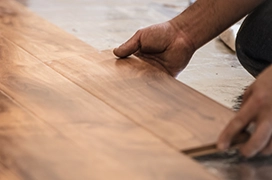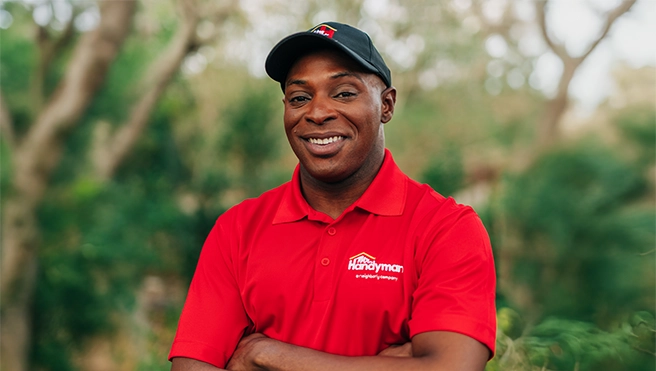Once you’ve had a look at our comprehensive guide to flooring installation and have decided on the right flooring for you, your home, and your lifestyle, our professional installers will be happy to put it in for you. We’ve worked with all types of Boulder flooring and room shapes, so you can be confident that we’ll pull off your service without a hitch.
Hardwood Flooring Installation
For the last couple of hundred years, solid hardwood flooring has been a staple in American homes. As a testament to this material’s durability, some historic homes still have their original hardwood. Though this option is a little pricier than others, there’s nothing quite like a natural hardwood floor to make your home feel warm and cozy. Plus, if it gets scuffed and scratched—which it inevitably will—it can be refinished down the line.
There are tons of different types of hardwood. While having lots of options is great, it can also make the decision process more difficult. Some factors you’ll want to consider when picking the right hardwood for you include:
- Finish: Do you want the surface to be smooth or textured? Shiny or matte? Glossy finishes tend to show dirt and scuffs more, so if you have an active household, a more matte finish may be the most practical choice.
- Plank Width: For many years, almost all hardwood planks were between 2 and 3 inches in width. Today, wide planks—we’re talking between 6 and 10 inches wide—are the standard. Wide planks look great in large rooms, but a more narrow plank is better suited for small rooms, such as powder rooms. Or, you can go in the middle and opt for 4- or 5-inch planks.
- Wood Type: For decades, oak was the wood of choice for American homes. Because this neutral-toned wood can be stained any color you choose, it’s still a great, versatile option, but if you want to use wood that doesn’t have to be stained, some other options include Brazilian cherry, Brazilian ebony, and American walnut.
No matter which style combinations you choose, our Boulder flooring experts can install your Colorado hardwood flooring to a professional standard. Not sure which material is right for you? We’re happy to provide recommendations based on our extensive industry knowledge.
Laminate and Vinyl Installation
If wood flooring is a little bit outside of your budget, laminate flooring or vinyl flooring are both great alternatives. A few decades ago, laminate and vinyl were very clearly not wood, but today, thanks to advances in technology, this innovative wood alternative is almost indistinguishable from real wood.
Like real wood, laminate and vinyl come in a wide range of colors and styles. They’re also easier to install, as they ‘click’ into place. If you have a home filled with pets or kids, or you simply like to entertain a lot, vinyl or laminate flooring is an excellent choice. They come in many different varieties that offer benefits such as scratch resistance, water resistance, and scuff resistance for high-traffic areas.
While these two options are made from synthetics, they are made to look just like natural materials and really replicate the beauty of wood grain. When in need of repair, instead of sanding down the wood and restaining it as you would with hardwood, the process entails popping out the damaged plank and popping a new one.
As for their prices, laminate is an even more affordable option than vinyl floor installation; however, it's slightly lower in quality.
Tile Installation
For thousands of years, tile has remained a popular flooring choice in homes all over the world. This material is generally easy to clean, waterproof or water-resistant and comes in a variety of sizes, colors, timeless styles, and finishes to create almost endless design possibilities.
We can install all types of tile floors and have experience with the following materials:
- Ceramic tiles
- Porcelain tiles
- Glass tiles
- Mosaic tiles
- Marble tiles
- Granite tiles
- Vinyl tiles
- Slate tiles
- Natural stone tiles
- Cork floors
- And more!
One of the only drawbacks of tile floors is that they can be slippery surfaces. Thankfully, there are non-slip styles of tile to choose from for your bathroom floors. If, after looking at the pros and cons of tile installation, you decide that this is the right choice for your home, our handyman experts can prepare the underlayment, lay your tiles, and add a sealant to ensure your Boulder flooring will look its best for decades. The overall cost of floor installation when choosing tile is substantially lower than some other types of flooring. This is thanks to the very low price of certain tiles, such as ceramic.
Flooring Installation in Boulder, CO: The Process
Wondering what to expect when you choose us to do your flooring installation in Boulder, CO? All of our handyman experts may follow slightly different steps, but rest assured that they know what they’re doing and are committed to providing you with a stunning finished product. To give you some idea of what to expect, our flooring installation service generally looks something like this:
Step 1: Initial Estimate
Your service starts when you contact us with your project details and request a service appointment. For flooring installations in Boulder, CO, we can come to your place to take measurements and assess the work that needs to be done to provide you with an estimate.
After we’ve discussed your project details and answered any questions you may have, if you’re happy to go ahead with service, we’ll book you in for a service appointment on the day and time that works best for your schedule.
Step 2: Subfloor Preparation
On the day of your appointment, our team will show up on time and be ready to work. Your Boulder flooring installation will start with subfloor prep to make sure that we have a level, even base, to place your planks or tiles on top of.
In some cases, laminate and vinyl flooring may be installed directly on top of existing vinyl flooring as long as it’s in good condition and there’s enough room to do so. Otherwise, we’ll remove your old flooring (if you haven’t done so already), clean it up, and ensure that the subfloor’s moisture level is within the normal range. Then, we’ll add an underlayment.
Different underlayment materials are suitable for different types of flooring. For tile, backer board is typically used to provide cushioning and support, while vinyl can go directly on top of the plywood.
Step 3: Flooring Installation
Once your underlayment has been installed, we’ll move on to the actual flooring installation. Again, the best installation method will depend on the type of flooring material you’ve chosen.
Because vinyl clicks into place and does not have to be glued or cured, it tends to be the quickest to install. Tile generally takes the longest, as several products must be applied and cured in succession. This service will, therefore, take more than one day to complete from start to finish.
Step 4: Cleanup
With your new flooring in place, we’ll take care to clean up thoroughly so that we leave your home just as clean as we found it. If you have any remaining questions, now is the perfect time to ask your flooring installer about them. Otherwise, feel free to give us a call in the coming days. We want you to be completely satisfied with your new flooring!





